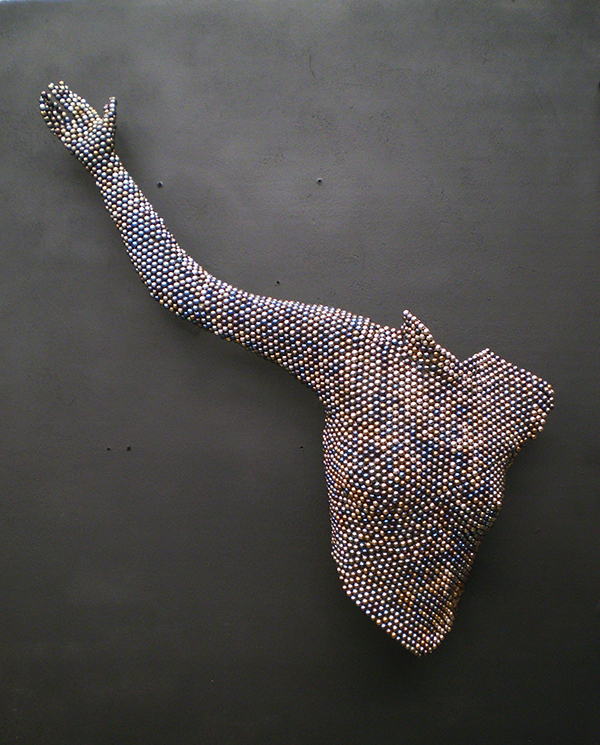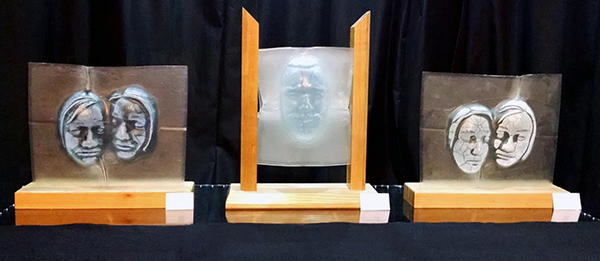
If you’re new to kennethcurtis.com, I’d first like to welcome you to the new design and hope that if you get a chance you’ll take a moment to look around. One of the many goals of this site is to create an area for artists of all kinds. It doesn’t matter if their chosen area is in fine arts or applied arts and even if they fall between the two, all are welcome.
As the function of the webmaster/creator of this site I get the honor and privilege to invite Greg Senn, one of my closest friends and favorite artists to be the first interview. As well as being a certified scuba diver for nearly twenty years, he has been an artist and art professor for about thirty years. Greg has primarily based his work on casting and metal work and it truly remarkable some of the pieces that he has created. His work ranges from serious to playful and he seems to revel in the freedom that art gives him.
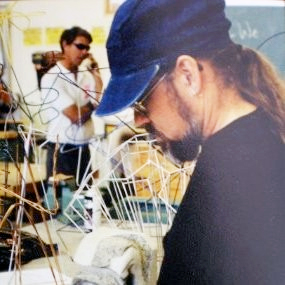
The following is a mix of supplied questions and giving Greg the freedom to write what he wanted:
KC: Hi Greg, Welcome to the site. Could you first give the readers a short introduction and history about yourself?
GS: I am a practicing artist working predominantly in metals and glass at this point in my aesthetic career. I started college as a science major – an interest in marine biology. I had to take some of those “gen ed” classes and managed to get into a ceramics class. At the end of my first semester I knew I was changing majors. I started “arting” in clay, and took a ceramics class with a kick ass ceramist named Ron Lang. His artwork and his encouragement resulted in changing my undergraduate major from biology to art.
I did the standard art curriculum as an undergrad and focused on ceramic sculpture and sculpture in grad school as well. I was lucky to land a teaching position (with much help and encouragement from my wife, Barbara) which fed us and my two children. I love teaching – at least the classroom part of it. The “kids” are awesome for the most part and watching them develop creatively and aesthetically is an incredibly rewarding and enriching experience. As with any job when working for someone else there are hoops to jump through and they do tend to take some of the fun out of the job. But the rewards have continued to outweigh the drawbacks so far.
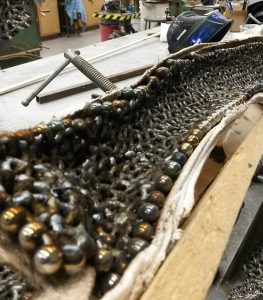
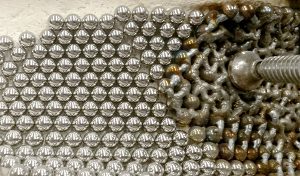
KC: What kind of artistic work are you currently doing? Are there any special techniques or processes that are needed?
GS: Currently I am working figuratively. My early ceramic and wooden forms tended to be biomorphic – in part due to my early interest in science I suspect. I have transitioned from abstract forms to life size figure pieces which are semi abstract. I have moved from working only in ceramics to working with glass and steel. The move has been a fun change with new challenges and processes.
KC: Can you give an insight to the creation of your work?
GS: I am using plaster bandage to create figure shells which I am using to hold steel balls while I weld them together. It’s a slow process as I have to let it cool so that I can keep the heat colors created by the welding process.
KC: Knowing you for so long, I often remember that you would have chainmaille just laying around your shop. Are you still doing that?
GS: I make jewelry and small sculptures for kicks and grins. Chainmaille jewelry, hacky sacks and odds and ends as giveaways and leave behinds.
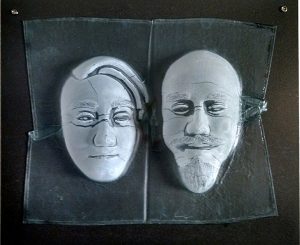 KC: Do you consider your work to be serious?
KC: Do you consider your work to be serious?
GS: Is my work serious? Generally, I make my work for ME – I get an idea that I want to try and do my best to bring it into existence. I get bored easily and doing one kind of art “thing” over and over again gets old – although my favorite sculpture instructor/mentor Bud Wall told me that THE way to get famous/make a living at art was to do the same thing over and over and over again – to specialize. I have too much fun trying different things to do that. Much of my work has an idea (concept) behind it but that is often obscure and not readily accessible by the viewer. I do my best to make my work aesthetically appealing – and find that generally it will stand on its own on that basis. I do get a kick out of people’s interpretations – and really enjoy it when they see what I was thinking during fabrication. But serious commentary? Not generally. I am a concerned citizen looking at at world which appears to be degrading rapidly, I am not try to change the world through my art.
KC: What drew you towards ceramics?
GS: Clay is the quintessential liar – one can make it look like almost anything else and that was very intriguing. So I changed majors to art and did a lot of clay – taking other art courses as required to get an undergrad degree. I took a few education classes with an eye toward teaching and decided that if those classes had any basis in reality there was no way I could teach high school. So my wife and I hunted for grad programs in small schools someplace warm. I did my graduate work in ceramic sculpture and sculpture and soaked up art history to go along with it. I also took an aesthetics class – the philosophy of art – and enjoyed the hell out of it. Steve Mayes challenged my thinking hard – but it prepared me for future student discussions and the writing of the thesis.
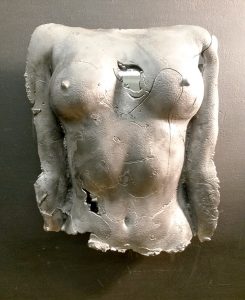
KC: Why did you make the move to predominately working in metal?
GS: Job hunting after grad school landed me in a small school in New Mexico. I was hired to teach sculpture and jewelry rather than ceramics and over the next ten years my work moved from clay to metal. And ten years ago I got started manipulating glass for a series of potential commissions. I have been working life size figuratively since.
I was approached to make before and after casts for a woman’s breast cancer survivor center. The original thought was to do casts before surgery and after healing to be hung as wall pieces. The original thought was doing do them in ceramic or glass. I told them that ceramic ones would be pretty straight forward but that I had no real clue on the glass. While the survivor center idea fell through with the economic crunch in ’09 the challenge started me off in a new direction.
I have done face and body casts for students for 30 years so the plaster part of the process was pretty straightforward. To do glass casts required a new set of techniques and materials. I am using skin safe silicone rubber molds to create plaster positives which I can slump mold glass sheets over. The process is not consistent but some of the pieces that don’t work turn into art pieces rather than “just portraits”. I am also using a polyurethane rubber to create positives – which lets me make plaster negatives in which I can cast glass positives. Depending on what I need to end up with for a finished product and what I have to start with I may make 4 or five molds for a single piece
In the hope of getting his insight to art in general, I followed up with some questions that are nearly impossible for anybody to answer.
KC: I hope that you don’t mind if I put you on “the hot seat” for a few questions. Speaking specifically about fine art, do you consider there to be a difference in the art of those of us who create for ourselves or those that seem to create something specifically for profit, social change, or for notoriety/fame?
GS: I ask my design students to define art in their own words as part of a class project. And then to define conceptual art. I create for myself – or on commission. The only difference I make between the two is one of intent. Those who create with an agenda put more “content” in the work and the work may well have multiple levels of meaning. This tends to make it “better” in terms of “historical” content but not necessarily in terms of visual impact. Art or “just shit”? Shitty art? $300,000….. Art created for aesthetic/visual impact my run light on message but be absolutely breathtaking visually. Art created for shock value may not have either of those two redeeming qualities. 😀
KC: Taking that a little further, where is the value in art? Is artwork better if someone is willing to purchase it? Or if the purchase price is higher than another piece, does that make it better?
GS: Ah, aesthetics! There is art made which cannot be sold – ephemeral sand sculpture, ice sculpture, beach sand drawings, drawings in snow, and installation art which is built and removed. In theory art which works on multiple levels is “better” than art which works on fewer – fewer being something like “Sunday painter” pieces of still life flowers and red barn landscapes. It is an apple to oranges comparison for me – I like both. And bananas, raisins and watermelon. 🙂 Art “value” these days is determined by location, critics, gallery sponsorship, being in the right place at the right time. There is so much kick ass art being created these days that will never be seen by more than a handful of people, and so many truly talented artist creating on a shoestring because that is all they can afford and yet are addicted to making. that the thought brings tears to my eyes. The internet is a gift for those with time to surf it. Yafro, Stumbleupon, Tumblr, Instagram, Deviantart, and the rest of the image sharing options allow those with time to experience some truly awe inspiring work which would never be seen any other way. Better? Content, intent, and aesthetics – just different.
KC: If there was anything that you could tell someone about art, maybe something that you wished someone would have told you, what would you say?
GS: Best advice I ever got was “Your work sucks, get out of art.” If you do not have to make art, don’t. There are much easier ways to make a living that may be far more rewarding. IF you HAVE to make art – and you want to BE an ARTIST, pick one thing and do it over and over and over again – become the BEST at whatever niche you can fit yourself into. If you are a “maker” like me, find a job that lets you support your creative addiction. I make my art for me. I do commissions for others – but I am very selective and tend to do them MY way.
KC: Is there any place that someone could find more about you or your work or maybe contact you?
GS: I am easy to find if you are interested – I post sporadic process pics of my work on Facebook and have a website which is sorely neglected. Shoot me an email or a message on Facebook. 😀 I do have a relatively uncommon name and a web search will usually pull me up.
KC: Thank you Greg for taking the time and giving the first interview on kennethcurtis.com. I know maybe some of the questions were kind of strange, or maybe a little weak, but you handled it like a pro. It’s been a sincere pleasure interviewing you.
For more about Greg and his work you can find some of his older work at
personal web site. or contact him

